Multifactor Configurational Pathways Driving the Eco-Efficiency of Cultivated Land Utilization in China: A Dynamic Panel QCA
Abstract
1. Introduction
2. Theoretical Framework
3. Research Design
3.1. Research Methodology
3.1.1. Super-SBM Model with Undesirable Outputs
3.1.2. Dynamic QCA
3.1.3. Necessary Condition Analysis
3.2. Index Selection
3.2.1. Outcome Variable
3.2.2. Conditional Variable
3.3. Data Calibration
3.4. Study Area
3.5. Data Source
4. Results
4.1. Necessity Analysis of Single Conditions
4.1.1. Necessity Analysis
4.1.2. Necessity Analysis of a Single Condition in QCA
4.2. Configuration Analysis
4.3. Pooled Results Analysis
- (1)
- Economy–Technology–Government Synergistic Pathway. The configuration H1a demonstrates a consistency of 0.925 and a coverage of 0.391, indicating that 39.1% of the cases can be accounted for by this configuration. Its core conditions are a high GPC, high STI, low AMD, and high GAEI, with a high UL serving as a peripheral condition. This combination is sufficient to attain a high ECLU. The configuration H1b explains 24% of the cases, as it achieves a consistency of 0.942 and a coverage of 0.240. Although it shares the same core conditions—high GPC, high STI, low AMD, and high GAEI—it relies on a high MCI and high ACL as peripheral conditions to achieve a high ECLU. Thus, both configurations have identical cores, while their peripheral conditions are substitutable. Financial and technological resources can compensate for lower mechanization density or limited natural endowments in provinces with a strong economic capacity, active agricultural innovation, and robust policy support. This enables precise and efficient resource allocation and, ultimately, a high ECLU. Regions with higher levels of economic development typically command greater advantages in the allocation of agricultural inputs, enabling them to raise the ECLU [72]. Shanghai illustrates this dynamic. As China’s economic center, Shanghai leverages its robust economic strength to keep upgrading agricultural production conditions and thus consistently raise ECLU. In 2021, Shanghai’s contribution rate of agricultural scientific and technological progress reached 79.09%, among the highest nationwide, and the city consistently ranks near the top in agricultural modernization and indigenous innovation capacity [73]. Policy support reinforces these strengths. In 2025, the municipal government issued the Implementation Opinions on Accelerating Agricultural Science-and-Technology Innovation, calling for an integrated innovation system that links universities, research institutes, and enterprises to boost in-house R&D and speed up the commercialization of research outputs. A 2024 notice—On the Allocation of Funds for Cultivated Land Fertility Protection Subsidies—directs government subsidies to soil fertility protection, promoting pollution abatement and carbon mitigation in cultivated land use and further enhancing the city’s ECLU.
- (2)
- Nature–Economy Dual-Driver Pathway. Configuration H2 obtains a consistency of 0.911 and a coverage of 0.299, indicating that 29.9% of the cases can be accounted for by this configuration. Its core conditions are a high ACL, high GPC, low MCI, and low AMD; a high UL and low STI serve as peripheral conditions. In practice, where natural constraints keep both re-cropping intensity and mechanization modest, expanding the scope of cultivated land operations, combined with strong economic resources, can offset limited technological input and still deliver a high ECLU. Inner Mongolia exemplifies this pathway. Owing to its climate, the region produces only one crop per year, yielding a low MCI. Yet, in 2023, its cultivated land endowment reached 11,466.7 kha—about 10% of China’s total and second only to Heilongjiang. In 2024, GPC stood at CNY 110,011, eighth nationwide and among the highest in China’s central–western region. Prior work contends that favorable economic conditions reinforce farmers’ ecological awareness and encourage conservation tillage, allowing land abundance to translate into a high ECLU despite technological limitations [74].
- (3)
- Government-Supported Land–Economy Pathway. Configuration H3a records a consistency of 0.926 and a coverage of 0.281, indicating that 28.1% of the cases can be accounted for by this configuration. Its core conditions are a high ACL, high GPC, high GAEI, and low MCI and STI; a high UL serves as a peripheral condition. Together, these features are sufficient to achieve a high ECLU. Configuration H3b achieves a consistency of 0.940 and a coverage of 0.267, accounting for 26.7% of the cases. It shares the same core conditions as H3a—high ACL, high GPC, high GAEI, and sub-threshold MCI and STI—and adds a low AMD. Thus, the two configurations possess identical cores and substitute each other in their peripheral requirements. Xinjiang exemplifies this pathway. The region’s contribution rate of agricultural scientific and technological progress has long lagged behind the national average [75], and its harsh inland climate limits multiple cropping, yielding a low MCI. Yet, Xinjiang commands vast cultivated land—about 7066.7 kha, or 5.5% of China’s total—and strong fiscal support: in 2024, budgetary expenditure on agriculture, forestry, and water affairs reached CNY 98.63 billion, up 22.6% year-on-year. By leveraging extensive land resources, a robust economic capacity, and vigorous government funding, Xinjiang compensates for technological and natural constraints and achieves a higher ECLU.
4.4. Between Results
4.5. Within Results
4.6. Configurational Analysis of Low ECLU
4.7. Further Analysis
4.8. Robustness Test
5. Discussion
Limitations and Future Work
6. Conclusions
6.1. Theoretical Implications
6.2. Practical Implications
- (1)
- For provinces aligning with the Economy–Technology–Government Synergistic Pathway, governments should effectively allocate agricultural fiscal resources by providing subsidies to farmers adopting efficient and environmentally friendly production inputs and offering targeted incentives for precision agriculture and other advanced technologies. Resources should also be strategically channeled into research and development for ecological agricultural technologies. Additionally, fiscal subsidies could prioritize reducing chemical fertilizers, minimizing pesticide use, and enhancing soil remediation. Financial instruments, such as green agricultural bonds, may further accelerate the adoption of energy-efficient agricultural machinery. In regions characterized by fragmented farmland ownership, governments could facilitate land transfers to enable large-scale cultivation, with cooperatives or professional agricultural service providers delivering technical support and mechanized services.
- (2)
- For provinces characterized by the Nature–Economy Dual-Driver Pathway, governments should enhance fiscal investments in agriculture, particularly in farmland infrastructural improvements such as irrigation facilities, aiming to increase multiple-cropping indices and mechanization levels. Collaboration with local research institutes, universities, and technical colleges is also essential to deliver targeted farmer training, facilitate the dissemination of agricultural scientific knowledge, and provide tailored technological support. Moreover, the promotion of regionally appropriate green cultivation practices and strengthened investment in digital agricultural infrastructure should be prioritized to elevate local agricultural technological capacities.
- (3)
- In provinces explained by the Government-Supported Land–Economy Pathway, governments should increase technical subsidies targeted towards regions lagging in agricultural technology. Research institutes and universities should be encouraged to develop new crop varieties and technologies specifically suited to areas with low MCI, such as drought-resistant, high-yield cultivars and conservation tillage machinery. Fiscal subsidies can then accelerate adoption, phasing out outdated, energy-intensive equipment, thereby enhancing the mechanization density while reducing resource consumption and emissions.
Supplementary Materials
Author Contributions
Funding
Data Availability Statement
Conflicts of Interest
Abbreviations
References
- Lambin, E.F.; Gibbs, H.K.; Ferreira, L.; Grau, R.; Mayaux, P.; Meyfroidt, P.; Morton, D.C.; Rudel, T.K.; Gasparri, I.; Munger, J. Estimating the World’s Potentially Available Cropland Using a Bottom-up Approach. Glob. Environ. Change 2013, 23, 892–901. [Google Scholar] [CrossRef]
- Su, M.; Guo, R.; Hong, W. Institutional Transition and Implementation Path for Cultivated Land Protection in Highly Urbanized Regions: A Case Study of Shenzhen, China. Land Use Policy 2019, 81, 493–501. [Google Scholar] [CrossRef]
- Li, X.; Zhao, L.; Chang, X.; Yu, J.; Song, X.; Zhang, L. Spatial and Temporal Evolution of the Eco-Efficiency of Cultivated Land Use in the Region around Beijing–Tianjin Based on the Super-EBM Model. Front. Ecol. Evol. 2023, 11, 1297570. [Google Scholar] [CrossRef]
- He, C.; Liu, Z.; Xu, M.; Ma, Q.; Dou, Y. Urban Expansion Brought Stress to Food Security in China: Evidence from Decreased Cropland Net Primary Productivity. Sci. Total Environ. 2017, 576, 660–670. [Google Scholar] [CrossRef]
- Liu, Y.; Zou, L.; Wang, Y. Spatial-Temporal Characteristics and Influencing Factors of Agricultural Eco-Efficiency in China in Recent 40 Years. Land Use Policy 2020, 97, 104794. [Google Scholar] [CrossRef]
- Cao, W.; Zhou, W.; Wu, T.; Wang, X.; Xu, J. Spatial-Temporal Characteristics of Cultivated Land Use Eco-Efficiency under Carbon Constraints and Its Relationship with Landscape Pattern Dynamics. Ecol. Indic. 2022, 141, 109140. [Google Scholar] [CrossRef]
- Schaltegger, S.; Sturm, A. Ökologische Rationalität: Ansatzpunkte Zur Ausgestaltung von Ökologieorientierten Managementinstrumenten. Die Unternehm. 1990, 44, 273–290. [Google Scholar]
- Yin, Y.; Hou, X.; Liu, J.; Zhou, X.; Zhang, D. Detection and Attribution of Changes in Cultivated Land Use Ecological Efficiency: A Case Study on Yangtze River Economic Belt, China. Ecol. Indic. 2022, 137, 108753. [Google Scholar] [CrossRef]
- Dahlström, K.; Ekins, P. Eco-Efficiency Trends in the UK Steel and Aluminum Industries. J. Ind. Ecol. 2005, 9, 171–188. [Google Scholar] [CrossRef]
- Yang, B.; Zhang, Z.; Wu, H. Detection and Attribution of Changes in Agricultural Eco-Efficiency within Rapid Urbanized Areas: A Case Study in the Urban Agglomeration in the Middle Reaches of Yangtze River, China. Ecol. Indic. 2022, 144, 109533. [Google Scholar] [CrossRef]
- Wang, Q.; Wei, M.; Wang, N.; Chen, Q. The Impact of Human Capital and Tourism Industry Agglomeration on China’s Tourism Eco-Efficiency: An Analysis Based on the Undesirable Super-SBM-ML Model. Sustainability 2024, 16, 6918. [Google Scholar] [CrossRef]
- Wang, X.; Wang, D. Breaking Spatial Constraints: A Dimensional Perspective-Based Analysis of the Eco-Efficiency of Cultivated Land Use and Its Spatial Association Network. Land 2024, 13, 2221. [Google Scholar] [CrossRef]
- Liu, M.; Zhang, A.; Wen, G. Regional Differences and Spatial Convergence in the Ecological Efficiency of Cultivated Land Use in the Main Grain Producing Areas in the Yangtze Region. J. Nat. Resour. 2022, 37, 477. (In Chinese) [Google Scholar] [CrossRef]
- Ke, X.; Zhang, Y.; Zhou, T. Spatio-Temporal Characteristics and Typical Patterns of Eco-Efficiency of Cultivated Land Use in the Yangtze River Economic Belt, China. J. Geogr. Sci. 2023, 33, 357–372. [Google Scholar] [CrossRef]
- Fan, Y.; Ning, W.; Liang, X.; Wang, L.; Lv, L.; Li, Y.; Wang, J. Spatial–Temporal Characteristics and Influencing Factors of Eco-Efficiency of Cultivated Land Use in the Yangtze River Delta Region. Land 2024, 13, 219. [Google Scholar] [CrossRef]
- Lin, Q.; Bai, S.; Qi, R. Cultivated Land Green Use Efficiency and Its Influencing Factors: A Case Study of 39 Cities in the Yangtze River Basin of China. Sustainability 2024, 16, 29. [Google Scholar] [CrossRef]
- Li, M.; Tan, L.; Yang, X. The Impact of Environmental Regulation on Cultivated Land Use Eco-Efficiency: Evidence from China. Agriculture 2023, 13, 1723. [Google Scholar] [CrossRef]
- Hou, X.; Liu, J.; Zhang, D.; Zhao, M.; Xia, C. Impact of Urbanization on the Eco-Efficiency of Cultivated Land Utilization: A Case Study on the Yangtze River Economic Belt, China. J. Clean. Prod. 2019, 238, 117916. [Google Scholar] [CrossRef]
- Feng, L.; Lei, G.; Nie, Y. Exploring the Eco-Efficiency of Cultivated Land Utilization and Its Influencing Factors in Black Soil Region of Northeast China under the Goal of Reducing Non-Point Pollution and Net Carbon Emission. Environ. Earth Sci. 2023, 82, 94. [Google Scholar] [CrossRef]
- Zhang, N.; Sun, F.; Hu, Y. Carbon Emission Efficiency of Land Use in Urban Agglomerations of Yangtze River Economic Belt, China: Based on Three-Stage SBM-DEA Model. Ecol. Indic. 2024, 160, 111922. [Google Scholar] [CrossRef]
- Liangjian, W.; Hui, L. Cultivated Land Use Efficiency and the Regional Characteristics of Its Influencing Factors in China: By Using a Panel Data of 281 Prefectural Cities and the Stochastic Frontier Production Function. Geogr. Res. 2015, 33, 1995–2004. [Google Scholar]
- Zou, X.; Xie, M.; Li, Z.; Duan, K. Spatial Spillover Effect of Rural Labor Transfer on the Eco-Efficiency of Cultivated Land Use: Evidence from China. Int. J. Environ. Res. Public Health 2022, 19, 9660. [Google Scholar] [CrossRef] [PubMed]
- Huang, K.; Tang, W.; Zhou, F. Agricultural Productive Services and Ecological Efficiency of Cultivated Land Use: Evidence from Hunan Province, China. Pol. J. Environ. Stud. 2024, 33, 5127–5140. [Google Scholar] [CrossRef] [PubMed]
- Wang, Y.; Wu, X.; Zhu, H. Spatio-Temporal Pattern and Spatial Disequilibrium of Cultivated Land Use Efficiency in China: An Empirical Study Based on 342 Prefecture-Level Cities. Land 2022, 11, 1763. [Google Scholar] [CrossRef]
- Ke, N.; Zhang, X.; Lu, X.; Kuang, B.; Jiang, B. Regional Disparities and Influencing Factors of Eco-Efficiency of Arable Land Utilization in China. Land 2022, 11, 257. [Google Scholar] [CrossRef]
- Liu, Q.; Qiao, J.; Han, D.; Li, M.; Shi, L. Spatiotemporal Evolution of Cultivated Land Use Eco-Efficiency and Its Dynamic Relationship with Landscape Pattern Change from the Perspective of Carbon Effect: A Case Study of Henan, China. Agriculture 2023, 13, 1350. [Google Scholar] [CrossRef]
- Fan, Z.; Luo, Q.; Yu, H.; Liu, J.; Xia, W. Spatial–Temporal Evolution of the Coupling Coordination Degree between Water and Land Resources Matching and Cultivated Land Use Eco-Efficiency: A Case Study of the Major Grain-Producing Areas in the Middle and Lower Reaches of the Yangtze River. Land 2023, 12, 982. [Google Scholar] [CrossRef]
- Kuang, B.; Lu, X.; Zhou, M.; Chen, D. Provincial Cultivated Land Use Efficiency in China: Empirical Analysis Based on the SBM-DEA Model with Carbon Emissions Considered. Technol. Forecast. Soc. Change 2020, 151, 119874. [Google Scholar] [CrossRef]
- Yang, B.; Wang, Z.; Zou, L.; Zou, L.; Zhang, H. Exploring the Eco-Efficiency of Cultivated Land Utilization and Its Influencing Factors in China’s Yangtze River Economic Belt, 2001–2018. J. Environ. Manag. 2021, 294, 112939. [Google Scholar] [CrossRef]
- Ma, Y.; Wang, X.; Zhong, C. Spatial and Temporal Differences and Influencing Factors of Eco-Efficiency of Cultivated Land Use in Main Grain-Producing Areas of China. Sustainability 2024, 16, 5734. [Google Scholar] [CrossRef]
- Lyu, T.; Fu, S.; Hu, H.; Wang, L.; Geng, C. Dynamic Evolution and Convergence Characteristics of Cultivated Land Green Use Efficiency Based on the Constraint of Agricultural Green Transition: Taking the Main Grain Producing Areas in the Middle Reaches of the Yangtze River as an Example. China Land Sci. 2023, 37, 107–118. (In Chinese) [Google Scholar]
- Ma, L.; Zhang, R.; Pan, Z.; Wei, F. Analysis of the Evolution and Influencing Factors of Temporal and Spatial Pattern of Eco-Efficiency of Cultivated Land Use among Provinces in China: Based on Panel Data from 2000 to 2019. China Land Sci. 2022, 36, 74–85. (In Chinese) [Google Scholar]
- Lu, X.; Kuang, B.; Li, J. Regional Differences and Its Influencing Factors of Cultivated Land Use Efficiency under Carbon Emission Constraint. J. Nat. Resour. 2018, 33, 657–668. [Google Scholar]
- Li, W.; Guo, J.; Xie, T. Impact of Non-Agricultural Labor Transfer on the Ecological Efficiency of Cultivated Land: Evidence from China. Agriculture 2025, 15, 1083. [Google Scholar] [CrossRef]
- Wang, J.; Su, D.; Wu, Q.; Li, G.; Cao, Y. Study on Eco-Efficiency of Cultivated Land Utilization Based on the Improvement of Ecosystem Services and Emergy Analysis. Sci. Total Environ. 2023, 882, 163489. [Google Scholar] [CrossRef] [PubMed]
- Li, S.; Mu, N.; Ren, Y.; Glauben, T. Spatiotemporal Characteristics of Cultivated Land Use Eco-Efficiency and Its Influencing Factors in China from 2000 to 2020. J. Arid Land 2024, 16, 396–414. [Google Scholar] [CrossRef]
- Wen, G.; Liu, M.; Hu, X.; Zhao, J. Spatial Correlation and Spatial Effect of Cultivated Land Use Ecological Efficiency in the Dongting Lake Plain. Sci. Geogr. Sin. 2022, 42, 1102–1112. [Google Scholar]
- Charnes, A.; Cooper, W.W.; Rhodes, E. Measuring the Efficiency of Decision Making Units. Eur. J. Oper. Res. 1978, 2, 429–444. [Google Scholar] [CrossRef]
- Wang, A.; Si, L.; Hu, S. Does China’s Outward Foreign Direct Investment Improve Carbon Emission Efficiency? The Heterogeneous Impact of Economic Development. Energy Policy 2025, 204, 114678. [Google Scholar] [CrossRef]
- Fertő, I.; Baráth, L.; Bojnec, Š. Gender-Based Differences in Eco-Efficient Farming. Sci. Rep. 2025, 15, 15895. [Google Scholar] [CrossRef]
- Xue, L.; Qu, A.; Guo, X.; Hao, C. Research on Environmental Performance Measurement and Influencing Factors of Key Cities in China Based on Super-Efficiency SBM-Tobit Model. Sustainability 2024, 16, 4792. [Google Scholar] [CrossRef]
- Tone, K. Dealing with Undesirable Outputs in DEA: A Slacks-Based Measure (SBM) Approach. Nippon Opereshonzu, Risachi Gakkai Shunki Kenkyu Happyokai Abusutorakutoshu. 2004, Volume 1, pp. 44–45. Available online: https://www.researchgate.net/publication/284047010_Dealing_with_undesirable_outputs_in_DEA_a_Slacks-Based_Measure_SBM_approach (accessed on 23 July 2025).
- Guo, I.-L.; Lee, H.-S.; Lee, D. An Integrated Model for Slack-Based Measure of Super-Efficiency in Additive DEA. Omega 2017, 67, 160–167. [Google Scholar] [CrossRef]
- Li, H.; Shi, J. Energy Efficiency Analysis on Chinese Industrial Sectors: An Improved Super-SBM Model with Undesirable Outputs. J. Clean. Prod. 2014, 65, 97–107. [Google Scholar] [CrossRef]
- Ragin, C.C. Redesigning Social Inquiry: Fuzzy Sets and Beyond; University of Chicago Press: Chicago, IL, USA, 2009. [Google Scholar]
- Wang, X.; Zhang, T.; Luo, S.; Abedin, M.Z. Pathways to Improve Energy Efficiency under Carbon Emission Constraints in Iron and Steel Industry: Using EBM, NCA and QCA Approaches. J. Environ. Manag. 2023, 348, 119206. [Google Scholar] [CrossRef] [PubMed]
- Garcia-Castro, R.; Ariño, M.A. A General Approach to Panel Data Set-Theoretic Research. J. Adv. Manag. Sci. Inf. Syst. 2016, 2, 63–76. [Google Scholar] [CrossRef]
- Beynon, M.J.; Jones, P.; Pickernell, D. Country-Level Entrepreneurial Attitudes and Activity through the Years: A Panel Data Analysis Using fsQCA. J. Bus. Res. 2020, 115, 443–455. [Google Scholar] [CrossRef]
- Dul, J. Necessary Condition Analysis (NCA): Logic and Methodology of “Necessary but Not Sufficient” Causality. Organ. Res. Methods 2016, 19, 10–52. [Google Scholar] [CrossRef]
- Sun, C.; Xia, E.; Huang, J.; Tong, H. Coupled Coordination and Pathway Analysis of Food Security and Carbon Emission Efficiency under Climate-Smart Agriculture Orientation. Sci. Total Environ. 2024, 948, 174706. [Google Scholar] [CrossRef]
- Chen, L.; Xue, L.; Xue, Y. Spatial-Temporal Characteristics of China’s Agricultural Net Carbon Sink. J. Nat. Resour. 2016, 31, 596–607. (In Chinese) [Google Scholar]
- Tian, Y.; Zhang, J. Regional Differentiation Research on Net Carbon Effect of Agricultural Production in China. J. Nat. Resour. 2013, 28, 1298–1309. (In Chinese) [Google Scholar]
- Rong, J.; Hong, J.; Guo, Q.; Fang, Z.; Chen, S. Path Mechanism and Spatial Spillover Effect of Green Technology Innovation on Agricultural CO2 Emission Intensity: A Case Study in Jiangsu Province, China. Ecol. Indic. 2023, 157, 111147. [Google Scholar] [CrossRef]
- West, T.O.; Marland, G. A Synthesis of Carbon Sequestration, Carbon Emissions, and Net Carbon Flux in Agriculture: Comparing Tillage Practices in the United States. Agric. Ecosyst. Environ. 2002, 91, 217–232. [Google Scholar] [CrossRef]
- Liu, M.; Yang, L. Spatial Pattern of China’s Agricultural Carbon Emission Performance. Ecol. Indic. 2021, 133, 108345. [Google Scholar] [CrossRef]
- Intergovernmental Panel on Climate Change (IPCC). Climate Change 2007: The Physical Science Basis. Contribution of Working Group I to the Fourth Assessment Report of the IPCC; Cambridge University Press: Cambridge, UK, 2007; Available online: https://archive.ipcc.ch/publications_and_data/ar4/wg1/en/contents.html (accessed on 23 July 2025).
- Li, B.; Zhang, J.; Li, H. Others Research on Spatial-Temporal Characteristics and Affecting Factors Decomposition of Agricultural Carbon Emission in China. China Popul. Resour. Environ. 2011, 21, 80–86. (In Chinese) [Google Scholar]
- Lai, S.; Du, P.; Chen, J. Evaluation of Non-Point Source Pollution Based on Unit Analysis. J.-Tsinghua Univ. 2004, 44, 1184–1187. (In Chinese) [Google Scholar]
- Liang, L. Study on the Temporal and Spatial Evolution of Rural Ecological Environment. Ph.D. Thesis, Nanjing Agricultural University, Nanjing, China, 2009. (In Chinese). [Google Scholar]
- Yan, K.; Tang, D.; Gan, T. Quantitative Evaluation and Dynamic Evolution of the Synergistic Effect of Agricultural Pollution and Carbon Reduction in China: An Analysis Based on Marginal Abatement Cost. Chin. Rural Econ. 2024, 9, 22–41. (In Chinese) [Google Scholar]
- Cheng, Y.; Zhang, D.; Wang, X. Green Development Effect of Agricultural Socialized Services: An Analysis Based on Farming Households’ Perspective. Resour. Sci. 2022, 44, 1848–1864. (In Chinese) [Google Scholar] [CrossRef]
- Pappas, I.O.; Woodside, A.G. Fuzzy-Set Qualitative Comparative Analysis (fsQCA): Guidelines for Research Practice in Information Systems and Marketing. Int. J. Inf. Manag. 2021, 58, 102310. [Google Scholar] [CrossRef]
- Ragin, C.C.; Drass, K.A.; Davey, S. Fuzzy-Set/Qualitative Comparative Analysis 2.0. Tucson Ariz. Dep. Sociol. Univ. Ariz. 2006, 23, 1949–1955. [Google Scholar]
- Xia, S.; Yang, Y.; Qian, X.; Xu, X. Spatiotemporal Interaction and Socioeconomic Determinants of Rural Energy Poverty in China. Int. J. Environ. Res. Public Health 2022, 19, 10851. [Google Scholar] [CrossRef]
- Du, Y.; Kim, P.H. One Size Does Not Fit All: Strategy Configurations, Complex Environments, and New Venture Performance in Emerging Economies. J. Bus. Res. 2021, 124, 272–285. [Google Scholar] [CrossRef]
- Dul, J. Conducting Necessary Condition Analysis for Business and Management Students; SAGE Publications Ltd.: Thousand Oaks, CA, USA, 2019. [Google Scholar]
- Dul, J.; Van der Laan, E.; Kuik, R. A Statistical Significance Test for Necessary Condition Analysis. Organ. Res. Methods 2020, 23, 385–395. [Google Scholar] [CrossRef]
- Schneider, C.Q.; Wagemann, C. Set-Theoretic Methods for the Social Sciences: A Guide to Qualitative Comparative Analysis; Cambridge University Press: Cambridge, UK, 2012. [Google Scholar]
- Tan, H.; Fan, Z.; Du, Y. Technology Management Capability, Attention Allocation, and Local Government Website Development: A Configuration Analysis Based on the TOE Framework. J. Manag. World 2019, 35, 81–94. (In Chinese) [Google Scholar]
- He, H.; Zhang, Z.; Ding, R.; Shi, Y. Multi-Driving Paths for the Coupling Coordinated Development of Agricultural Carbon Emission Reduction and Sequestration and Food Security: A Configurational Analysis Based on Dynamic fsQCA. Ecol. Indic. 2024, 160, 111875. [Google Scholar] [CrossRef]
- Rihoux, B.; Ragin, C. Configurational Comparative Methods: Qualitative Comparative Analysis (QCA) and Related Techniques; SAGE Publications, Inc.: Thousand Oaks, CA, USA, 2009. [Google Scholar]
- McMillan, J.; Whalley, J.; Zhu, L. The Impact of China’s Economic Reforms on Agricultural Productivity Growth. J. Political Econ. 1989, 97, 781–807. [Google Scholar] [CrossRef]
- Zhang, Q.; Wang, S.; Liu, C. Coordinated Development between Agricultural Modernization and Agricultural Insurance and the Influencing Factors in the Yangtze River Economic Belt. Resour. Environ. Yangtze Basin 2024, 33, 646–657. (In Chinese) [Google Scholar]
- Li, H.; Yang, H.; Wang, T.; Qi, M. Spatial-Temporal Differentiation of Ecological Efficiency of Cultivated Land Use and Its Configuration Paths in the Yangtze River Economic Belt. China Land Sci. 2024, 38, 114–124. (In Chinese) [Google Scholar]
- Zhang, Y.; Tang, H.; Tian, X. Research and Enlightenment on the Difference of Contribution Rate of Agricultural Science and Technology Progress in China since the Tenth FIve-Year Plan. Sci. Manag. Res. 2020, 38, 125–130. (In Chinese) [Google Scholar]
- Li, T.; Wang, Y.; Liu, C.; Tu, S. Research on Identification of Multiple Cropping Index of Farmland and Regional Optimization Scheme in China Based on NDVI Data. Land 2021, 10, 861. [Google Scholar] [CrossRef]
- Gao, H.; Yang, S. A Severe Drought Event in Northern China in Winter 2008–2009 and the Possible Influences of La Niña and Tibetan Plateau. J. Geophys. Res. Atmos. 2009, 114, D24104. [Google Scholar] [CrossRef]
- Yang, J.; Gong, D.; Wang, W.; Hu, M.; Mao, R. Extreme Drought Event of 2009/2010 over Southwestern China. Meteorol. Atmos. Phys. 2012, 115, 173–184. [Google Scholar] [CrossRef]
- Wang, P.; Zhang, L.; Lu, R. Evolution Characteristics and Mechanism of Cultivated Land Use Eco-Efficiency from the Triple-Security Perspective in China-Vietnam Border Area. Acta Ecol. Sin. 2024, 44, 4637–4649. (In Chinese) [Google Scholar]
- Hu, X.; Lin, X.; Wen, G.; Zhou, Y.; Zhou, H.; Lin, S.; Yue, D. The Impact of Cultivated Land Fragmentation on Farmers’ Ecological Efficiency of Cultivated Land Use Based on the Moderating and Mediating Effects of the Cultivated Land Management Scale. Land 2024, 13, 1628. [Google Scholar] [CrossRef]
- Zhang, S.; Cao, X. How Does Digital Governance Improve Natural Resource Utilization Efficiency? Configuration Analysis Based on the TOE Framework. Humanit. Soc. Sci. Commun. 2025, 12, 714. [Google Scholar] [CrossRef]
- Zhou, M.; Zhang, H.; Ke, N. Cultivated Land Transfer, Management Scale, and Cultivated Land Green Utilization Efficiency in China: Based on Intermediary and Threshold Models. Int. J. Environ. Res. Public Health 2022, 19, 12786. [Google Scholar] [CrossRef]
- Zhang, P.; Li, Y.; Yuan, X.; Zhao, Y. Effects of Off-Farm Employment on the Eco-Efficiency of Cultivated Land Use: Evidence from the North China Plain. Land 2024, 13, 1538. [Google Scholar] [CrossRef]
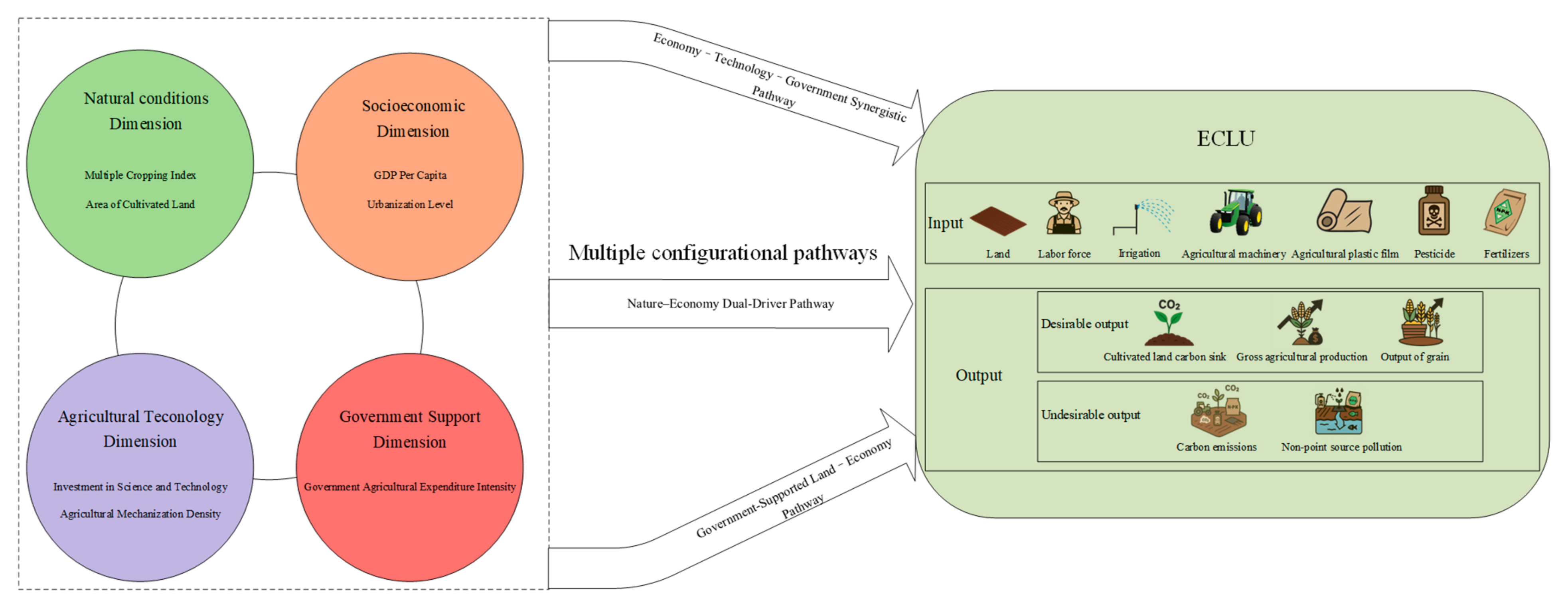
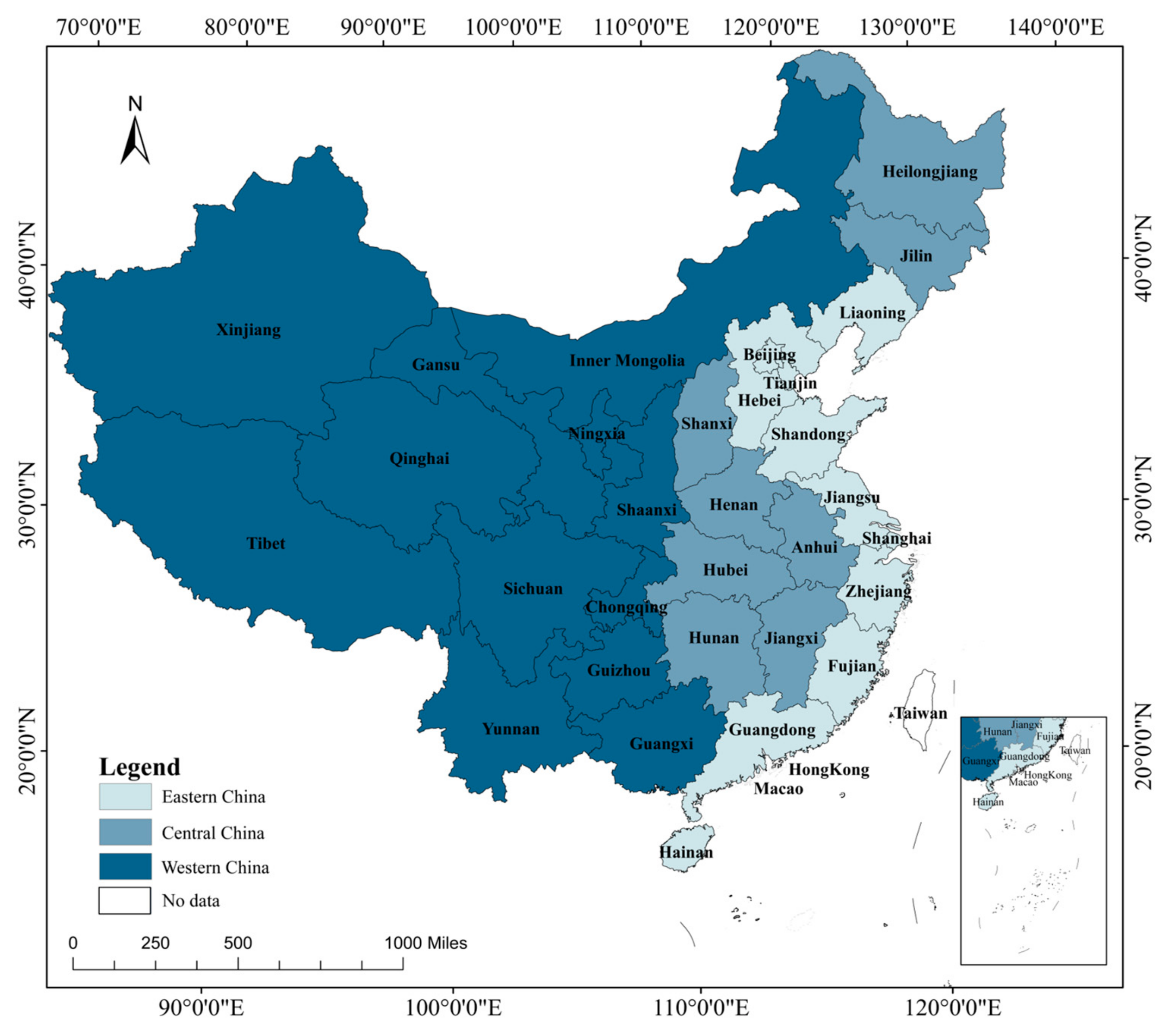
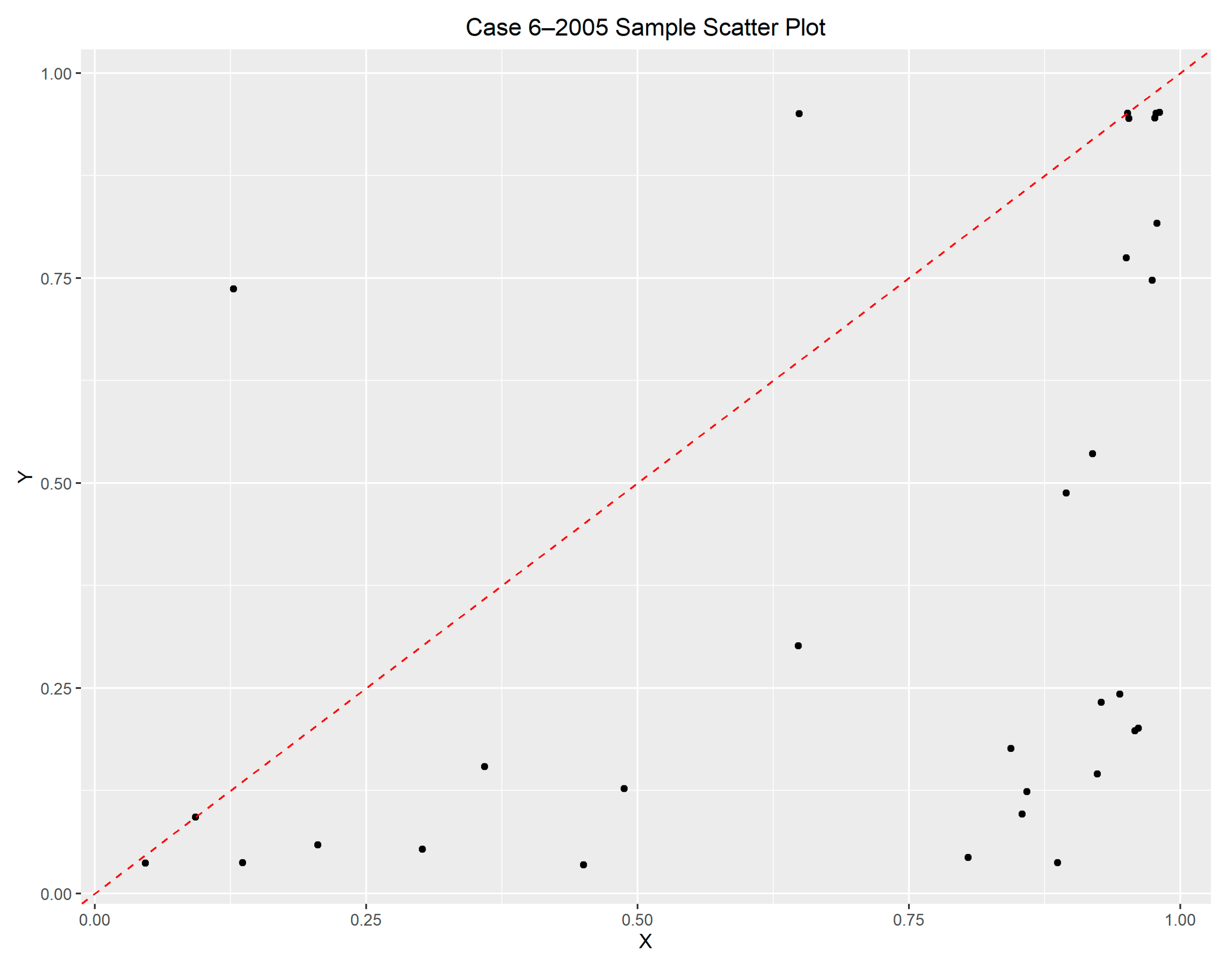

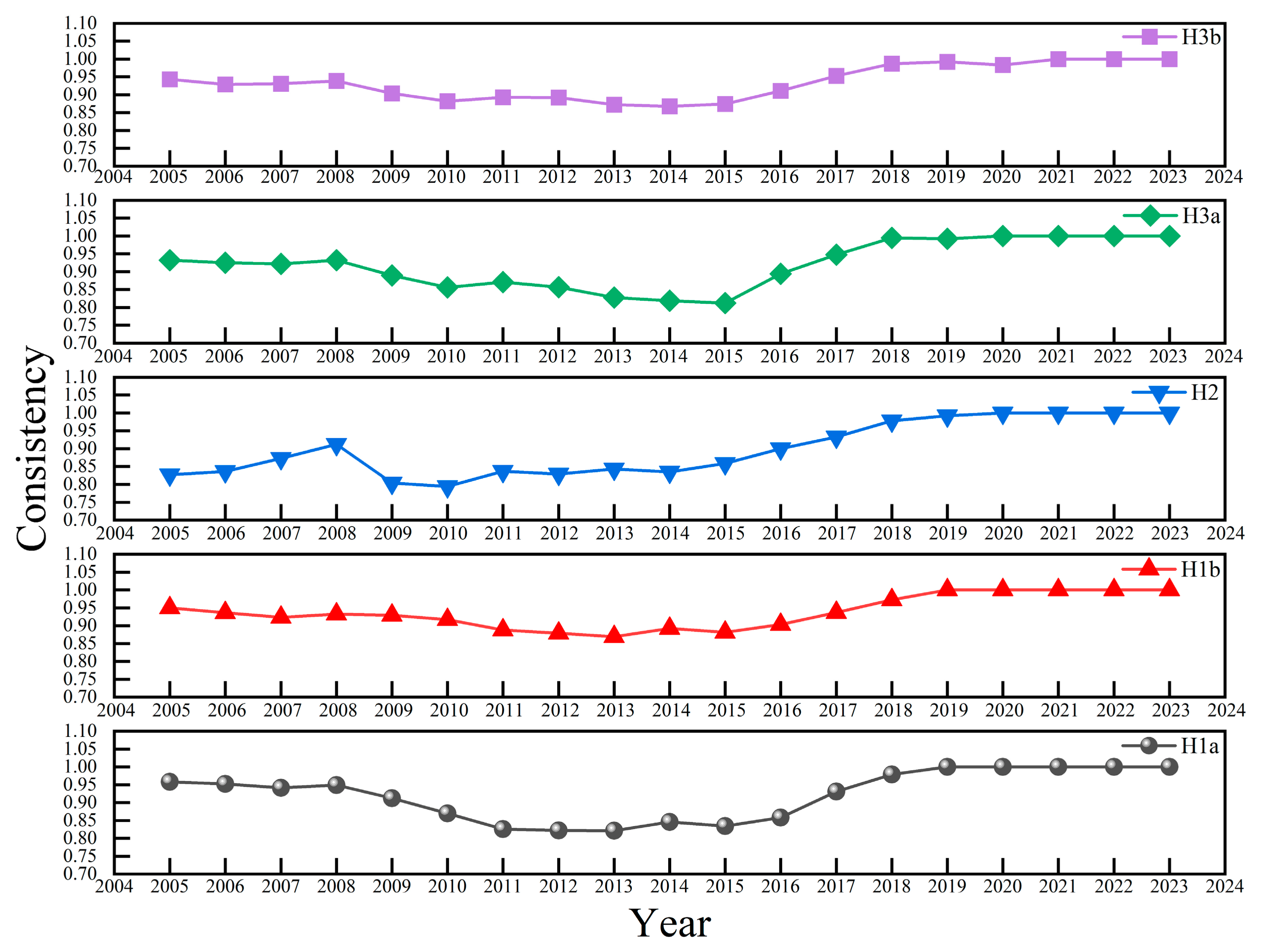
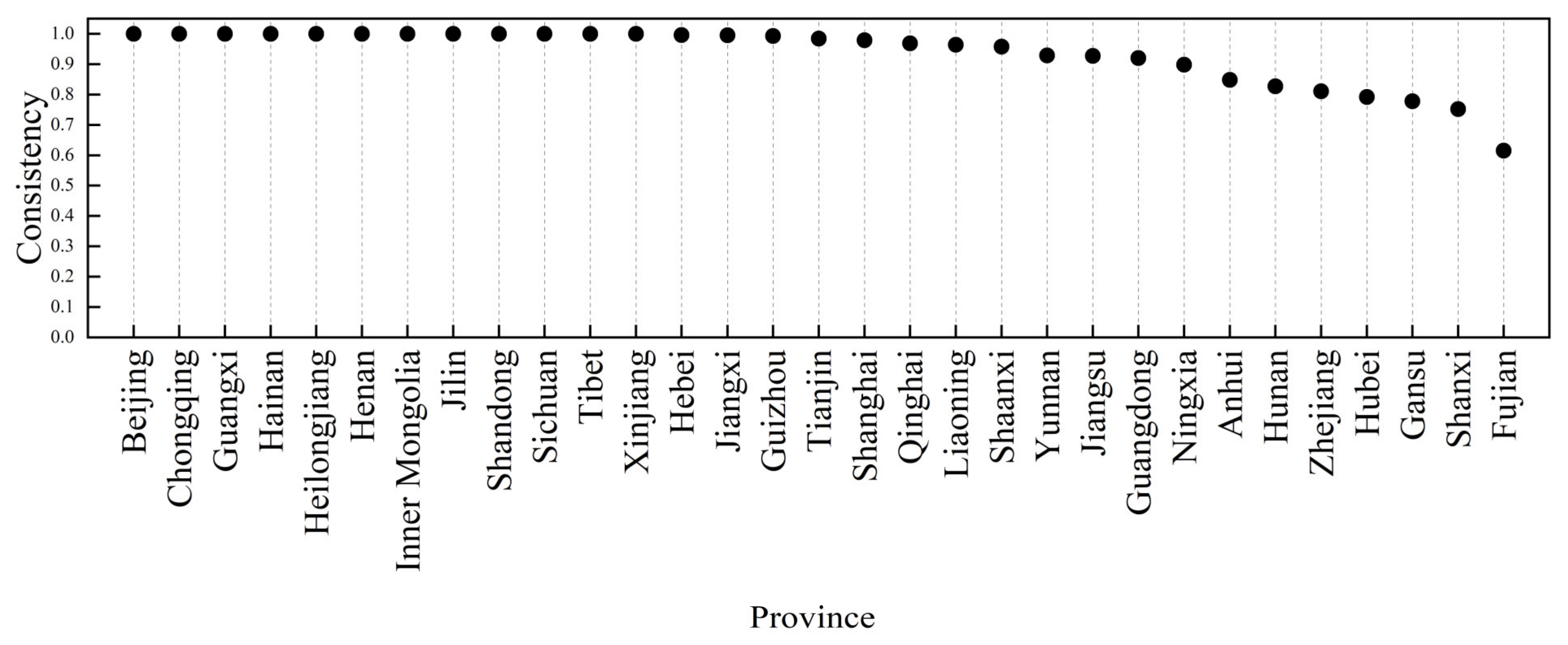

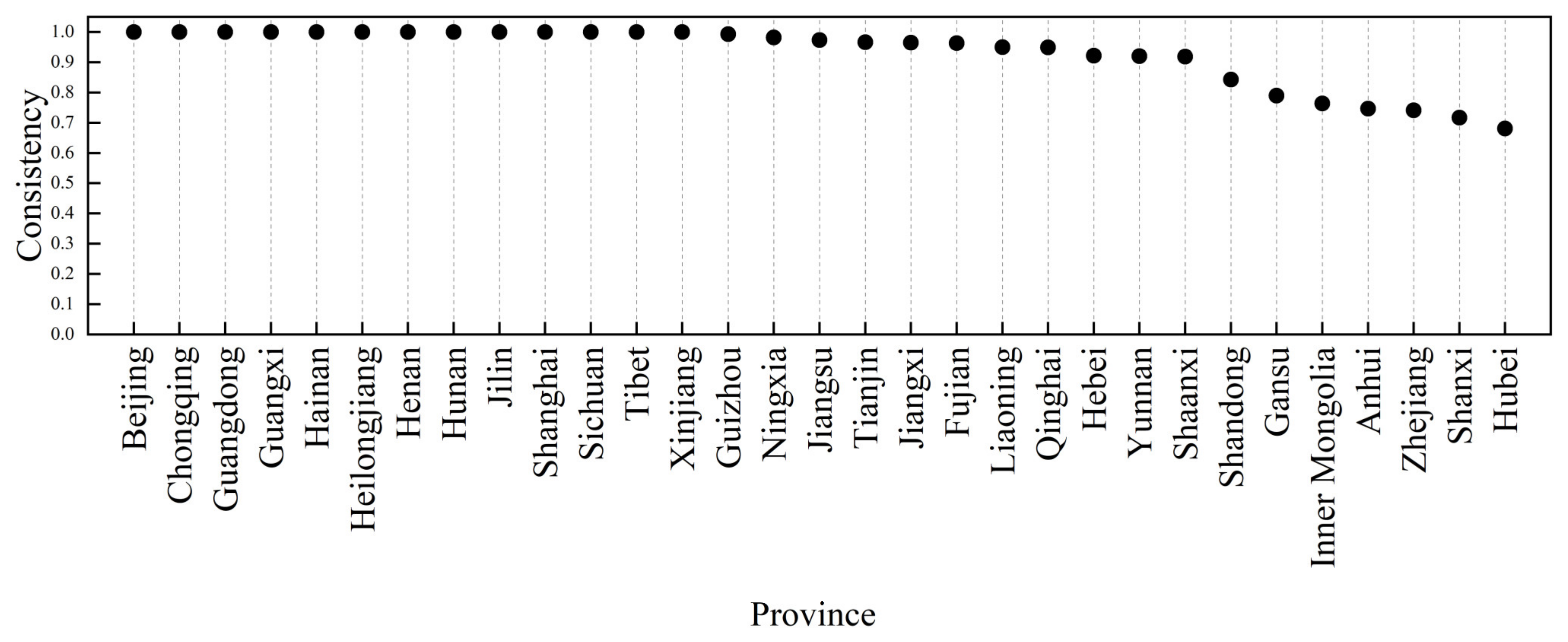

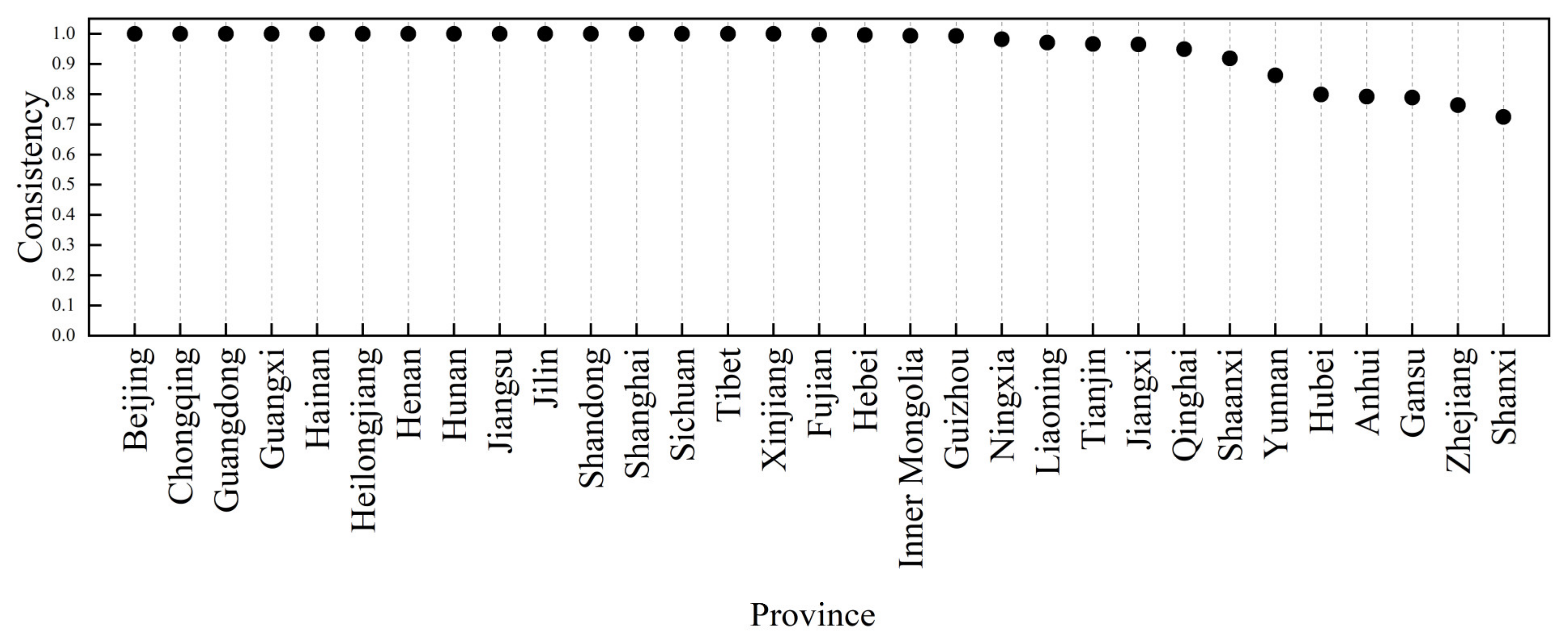
| Name | Variables | Description | Unit |
|---|---|---|---|
| Input | Land | Sown area of crops | 103 ha |
| Labor force | Agricultural workers | 104 People | |
| Irrigation | Effective irrigation area | 103 ha | |
| Agricultural machinery | Total power of agricultural machinery | 104 kW | |
| Agricultural plastic film | Consumption of agricultural plastic film | 104 T | |
| Pesticide | Consumption of pesticides | 104 T | |
| Fertilizers | Consumption of chemical fertilizers | 104 T | |
| Desirable output | Carbon sink | Total agricultural carbon sequestration | 104 T |
| Economic output | Gross agricultural production | 108 CNY | |
| Social output | Output of grain | 104 T | |
| Undesirable output | Carbon emissions | Total agricultural carbon emissions | 104 T |
| Non-point-source pollution | Total agricultural non-point-source pollution | 109 m3 |
| Crops |
Economic Coefficients | Moisture Contents (%) | Carbon Absorption |
|---|---|---|---|
| Rice | 0.45 | 12 | 0.414 |
| Wheat | 0.40 | 12 | 0.485 |
| Corn | 0.40 | 13 | 0.471 |
| Millet | 0.42 | 12 | 0.450 |
| Sorghum | 0.35 | 12 | 0.450 |
| Beans | 0.34 | 13 | 0.450 |
| Rapeseed | 0.25 | 10 | 0.450 |
| Peanuts | 0.43 | 10 | 0.450 |
| Sunflower seed | 0.30 | 10 | 0.450 |
| Cotton | 0.10 | 8 | 0.450 |
| Tubers | 0.70 | 70 | 0.423 |
| Sugarcane | 0.50 | 50 | 0.450 |
| Sugar beet | 0.70 | 75 | 0.407 |
| Vegetables (including cucurbits) | 0.60 | 90 | 0.450 |
| Tobacco leaf | 0.55 | 85 | 0.450 |
| Carbon Source | Carbon Emission Coefficient | Reference Source |
|---|---|---|
| Fertilizer | 0.8956 kg/kg | West et al. [54] |
| Pesticide | 4.9341 kg/kg | Liu et al. [55] |
| Agricultural plastic film | 5.18 kg/kg | Agricultural Resources and Ecological Environment Institute, Nanjing Agricultural University |
| Diesel | 0.5927 kg/kg | I.P.C.C. Climate Change The Fourth Assessment Report of the Intergovernmental Panel on Climate Change [56] |
| Tillage | 312.6 kg/km2 | College of Biotechnology, China Agricultural University |
| Agricultural irrigation | 20.476 kg/ha | Li et al. [57] |
| Dimension | Variable | Description | Reference Source |
|---|---|---|---|
| Natural conditions dimension | Multiple Cropping Index | Sown area of crops/total cultivated area (%) | Li et al. [36] |
| Area of Cultivated Land | Total cultivated area | Yang et al. [29] | |
| Socioeconomic dimension | GDP per Capita | GDP per capita at constant 2005 prices | Kuang et al. [28] |
| Urbanization Level | Urban population/total population (%) | Fan et al. [15] | |
| Agricultural technology dimension | Investment in Science and Technology | Local expenditures on science and technology/general budgetary expenditures of local governments | Li et al. [36] |
| Agricultural Mechanization Density | Total power of agricultural machinery/sown area of crops | Ma et al. [30] | |
| Government support dimension | Government Agricultural Expenditure Intensity | Budgetary expenditure on agriculture, forestry, and water affairs/sown area of crops | Lyu et al. [31] |
| Calibration | Descriptive Statistics | |||||||
|---|---|---|---|---|---|---|---|---|
| Variable Category | Variable | Full Membership | Crossover Point | Full Non-Membership | Mean | Standard Deviation | Min. | Max. |
| Outcome variable | ECLU | 1.01764367 | 0.56692627 | 0.362773932 | 0.6326724 | 0.2218311 | 0.3010296 | 1.062032 |
| Conditional variable | MCI | 211.241622 | 133.010315 | 75.6259658 | 133.022 | 44.76552 | 53.07357 | 253.5735 |
| ACL | 9195.156 | 4064.18 | 223.01 | 4152.403 | 3263.794 | 93.5 | 17,195.4 | |
| GPC | 86,595.0721 | 33,109.3577 | 11,025.43094 | 38,714.9 | 24,694.51 | 5184.857 | 142,784.9 | |
| UL | 86.26 | 55.49 | 33.692 | 55.95467 | 14.67222 | 20.85 | 89.6 | |
| STI | 5.40954175 | 1.33189921 | 0.676944618 | 2.017749 | 1.463377 | 0.3029005 | 7.201887 | |
| AMD | 12.0744796 | 5.59093644 | 2.995104944 | 6.480629 | 3.386691 | 2.105531 | 24.62582 | |
| GAEI | 74,125.7207 | 9425.1557 | 1169.77069 | 22,496.5 | 58,139.15 | 460.6958 | 659,842 | |
| Variable | Method | Ceiling Zone | Effect Size (d) | C-Accuracy (%) | p-Value |
|---|---|---|---|---|---|
| MCI | CE | 0 | 0 | 100% | 0.962 |
| CR | 0 | 0 | 99.50% | 0.953 | |
| ACL | CE | 0 | 0 | 100% | 0.95 |
| CR | 0 | 0 | 99.30% | 0.969 | |
| GPC | CE | 0.002 | 0.002 | 100% | 0.868 |
| CR | 0.002 | 0.002 | 99.70% | 0.868 | |
| UL | CE | 0.002 | 0.002 | 100% | 0.786 |
| CR | 0.02 | 0.022 | 95.40% | 0.474 | |
| STI | CE | 0 | 0 | 100% | 0.979 |
| CR | 0.003 | 0.003 | 99.00% | 0.836 | |
| AMD | CE | 0.004 | 0.005 | 100% | 0.445 |
| CR | 0.003 | 0.003 | 99.80% | 0.82 | |
| GAEI | CE | 0.008 | 0.008 | 100% | 0 |
| CR | 0.072 | 0.08 | 85.20% | 0.05 |
| ECLU | MCI | ACL | GPC | UL | STI | AMD | GAEI |
|---|---|---|---|---|---|---|---|
| 0 | NN | NN | NN | NN | NN | NN | NN |
| 10 | NN | NN | NN | NN | NN | NN | NN |
| 20 | NN | NN | NN | NN | NN | NN | NN |
| 30 | NN | NN | NN | NN | NN | NN | NN |
| 40 | NN | NN | NN | NN | NN | NN | NN |
| 50 | NN | NN | NN | NN | NN | NN | NN |
| 60 | NN | NN | NN | NN | 0 | NN | NN |
| 70 | NN | NN | NN | NN | 0.4 | NN | NN |
| 80 | NN | NN | NN | NN | 0.8 | NN | 14.4 |
| 90 | NN | NN | NN | NN | 1.2 | NN | 37.9 |
| 100 | 17.6 | 1.7 | 67.9 | 63.7 | 1.5 | 73.9 | 61.5 |
| Conditional Variable | High ECLU | Low ECLU | ||||||
|---|---|---|---|---|---|---|---|---|
| POCONS | POCOV | BECONS Adjusted Distance | WICONS Adjusted Distance | POCONS | POCOV | BECONS Adjusted Distance | WICONS Adjusted Distance | |
| MCI | 0.595 | 0.637 | 0.061121 | 0.577812 | 0.579 | 0.642 | 0.249186 | 0.560302 |
| ∼MCI | 0.666 | 0.604 | 0.178662 | 0.449409 | 0.673 | 0.632 | 0.150452 | 0.4319 |
| ACL | 0.59 | 0.628 | 0.14575 | 0.583648 | 0.6 | 0.662 | 0.23038 | 0.560302 |
| ∼ACL | 0.683 | 0.623 | 0.065823 | 0.4319 | 0.663 | 0.626 | 0.183363 | 0.466919 |
| GPC | 0.708 | 0.75 | 0.357323 | 0.321006 | 0.504 | 0.553 | 0.498372 | 0.461082 |
| ∼GPC | 0.578 | 0.529 | 0.371428 | 0.402717 | 0.772 | 0.732 | 0.112839 | 0.31517 |
| UL | 0.721 | 0.746 | 0.23038 | 0.326843 | 0.535 | 0.573 | 0.40434 | 0.496101 |
| ∼UL | 0.588 | 0.549 | 0.286799 | 0.396881 | 0.763 | 0.739 | 0.089331 | 0.350189 |
| STI | 0.641 | 0.658 | 0.112839 | 0.437736 | 0.593 | 0.631 | 0.23038 | 0.466919 |
| ∼STI | 0.641 | 0.603 | 0.17396 | 0.420227 | 0.679 | 0.662 | 0.075226 | 0.41439 |
| AMD | 0.58 | 0.599 | 0.225678 | 0.478591 | 0.651 | 0.696 | 0.263291 | 0.379371 |
| ∼AMD | 0.705 | 0.661 | 0.211573 | 0.391044 | 0.625 | 0.606 | 0.206871 | 0.478591 |
| GAEI | 0.649 | 0.758 | 0.34792 | 0.303497 | 0.507 | 0.613 | 0.564195 | 0.396881 |
| ∼GAEI | 0.669 | 0.567 | 0.253888 | 0.31517 | 0.8 | 0.703 | 0.155154 | 0.297661 |
| Conditional Variable | High ECLU | Low ECLU | ||||||
|---|---|---|---|---|---|---|---|---|
| H1a | H1b | H2 | H3a | H3b | H4 | H5 | H6 | |
| MCI |  |  |  |  |  |  |  | |
| ACL |  |  |  |  |  |  | ||
| GPC |  |  |  |  |  |  |  |  |
| UL |  |  |  |  |  |  | ||
| STI |  |  |  |  |  |  | ||
| AMD |  |  |  |  |  |  |  | |
| GAEI |  |  |  |  |  |  |  | |
| Consistency | 0.925 | 0.942 | 0.911 | 0.926 | 0.940 | 0.885 | 0.898 | 0.865 |
| PRI | 0.807 | 0.693 | 0.751 | 0.744 | 0.785 | 0.690 | 0.740 | 0.671 |
| Coverage | 0.391 | 0.24 | 0.299 | 0.281 | 0.267 | 0.293 | 0.299 | 0.314 |
| Unique coverage | 0.113 | 0.001 | 0.039 | 0.021 | 0.006 | 0.006 | 0.081 | 0.012 |
| BECONS adjusted distance | 0.0799276 | 0.05171786 | 0.0893308 | 0.075226 | 0.0517179 | 0.155153574 | 0.169258445 | 0.169258445 |
| WICONS adjusted distance | 0.1050567 | 0.08754722 | 0.1108931 | 0.1050567 | 0.0933837 | 0.180930926 | 0.157585 | 0.233459259 |
| Overall consistency | 0.901 | 0.863 | ||||||
| Overall PRI | 0.782 | 0.711 | ||||||
| Overall coverage | 0.507 | 0.413 | ||||||
| Regional | Economy–Technology–Government Synergistic Pathway | Nature–Economy Dual-Driver Pathway | Government-Supported Land–Economy Pathway | ||
|---|---|---|---|---|---|
| H1a | H1b | H2 | H3a | H3b | |
| Eastern China | 0.455 | 0.241 | 0.234 | 0.293 | 0.220 |
| Central China | 0.508 | 0.408 | 0.373 | 0.315 | 0.312 |
| Western China | 0.319 | 0.238 | 0.366 | 0.356 | 0.369 |
| Conditional Variable | Test | ||||
|---|---|---|---|---|---|
| J1 | J2 | J3 | J4 | J5 | |
| MCI | ⊗ | ⊗ | ⊗ | ● | |
| ACL | ● | ● | ● | ● | |
| GPC | ● | ● | ● | ● | ● |
| UL | ● | ● | ● | ||
| STI | ● | ⊗ | ⊗ | ⊗ | ● |
| AMD | ⊗ | ⊗ | ⊗ | ⊗ | |
| GAEI | ● | ● | ● | ● | |
| Consistency | 0.925 | 0.911 | 0.926 | 0.94 | 0.942 |
| PRI | 0.807 | 0.751 | 0.744 | 0.785 | 0.693 |
| Coverage | 0.391 | 0.299 | 0.281 | 0.267 | 0.24 |
| Unique coverage | 0.113 | 0.039 | 0.021 | 0.006 | 0.001 |
| Overall consistency | 0.901 | ||||
| Overall PRI | 0.782 | ||||
| Overall coverage | 0.507 | ||||
Disclaimer/Publisher’s Note: The statements, opinions and data contained in all publications are solely those of the individual author(s) and contributor(s) and not of MDPI and/or the editor(s). MDPI and/or the editor(s) disclaim responsibility for any injury to people or property resulting from any ideas, methods, instructions or products referred to in the content. |
© 2025 by the authors. Licensee MDPI, Basel, Switzerland. This article is an open access article distributed under the terms and conditions of the Creative Commons Attribution (CC BY) license (https://creativecommons.org/licenses/by/4.0/).
Share and Cite
Xu, Z.; Duan, J.; Zhan, L.; Yan, C.; Huang, Z. Multifactor Configurational Pathways Driving the Eco-Efficiency of Cultivated Land Utilization in China: A Dynamic Panel QCA. Land 2025, 14, 1549. https://doi.org/10.3390/land14081549
Xu Z, Duan J, Zhan L, Yan C, Huang Z. Multifactor Configurational Pathways Driving the Eco-Efficiency of Cultivated Land Utilization in China: A Dynamic Panel QCA. Land. 2025; 14(8):1549. https://doi.org/10.3390/land14081549
Chicago/Turabian StyleXu, Zihao, Jialong Duan, Lei Zhan, Chuanmin Yan, and Zhigang Huang. 2025. "Multifactor Configurational Pathways Driving the Eco-Efficiency of Cultivated Land Utilization in China: A Dynamic Panel QCA" Land 14, no. 8: 1549. https://doi.org/10.3390/land14081549
APA StyleXu, Z., Duan, J., Zhan, L., Yan, C., & Huang, Z. (2025). Multifactor Configurational Pathways Driving the Eco-Efficiency of Cultivated Land Utilization in China: A Dynamic Panel QCA. Land, 14(8), 1549. https://doi.org/10.3390/land14081549





